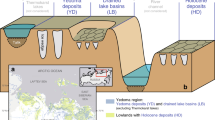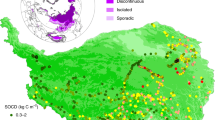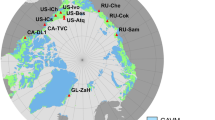Abstract
The carbon (C) balance of permafrost regions is predicted to be extremely sensitive to climatic changes1,2,3. Major uncertainties exist in the rate of permafrost thaw and associated C emissions (33–508 Pg C or 0.04–1.69 °C by 2100; refs 2, 3) and plant C uptake. In the High Arctic, semi-deserts retain unique soil–plant–permafrost interactions4,5 and heterogeneous soil C pools6 (>12 Pg C; ref. 7). Owing to its coastal proximity, marked changes are expected for High Arctic tundra8. With declining summer sea-ice cover9, these systems are simultaneously exposed to rising temperatures9, increases in precipitation10 and permafrost degradation11. Here we show, using measurements of tundra–atmosphere C fluxes and soil C sources (14C) at a long-term climate change experiment in northwest Greenland, that warming decreased the summer CO2 sink strength of semi-deserts by up to 55%. In contrast, warming combined with wetting increased the CO2 sink strength by an order of magnitude. Further, wetting while relocating recently assimilated plant C into the deep soil decreased old C loss compared with the warming-only treatment. Consequently, the High Arctic has the potential to remain a strong C sink even as the rest of the permafrost region transitions to a net C source as a result of future global warming.
This is a preview of subscription content, access via your institution
Access options
Subscribe to this journal
Receive 12 print issues and online access
$209.00 per year
only $17.42 per issue
Buy this article
- Purchase on Springer Link
- Instant access to full article PDF
Prices may be subject to local taxes which are calculated during checkout



Similar content being viewed by others
Change history
09 December 2013
In the version of this Letter originally published, in the legend for Fig. 2b, the label for Irrigation should have been 'W; 4 °C × W'. This error has now been corrected in all versions of the Letter.
References
Tarnocai, C. et al. Soil organic carbon pools in the northern circumpolar permafrost region. Glob. Biogeochem. Cycles 23, GB2023 (2009).
Schneider von Deimling, T. et al. Estimating the near-surface permafrost-carbon feedback on global warming. Biogeosciences 9, 649–665 (2012).
MacDougall, A. H., Avis, C. A. & Weaver, A. J. Significant contribution to climate warming from the permafrost carbon feedback. Nature Geosci. 5, 721 (2012).
Czimczik, C. I. & Welker, J. M. Radiocarbon content of CO2 respired from high arctic tundra in Northwest Greenland. Arct. Antarct. Alpine Res. 42, 342–350 (2010).
Walker, D. A. et al. Arctic patterned-ground ecosystems: A synthesis of field studies and models along a North American Arctic Transect. J. Geophys. Res. 113, G03S01 (2008).
Horwath, J. L. Quantification and Spatial Assessment of High Arctic Soil Organic Carbon Storage in Northwest Greenland PhD Thesis, Univ. Washington (2007).
Burnham, J. H. & Sletten, R. S. Spatial distribution of soil organic carbon in northwest Greenland and underestimates of high Arctic carbon stores. Glob. Biogeochem. Cycles 24, GB3012 (2010).
Bhatt, U. S. et al. Circumpolar Arctic tundra vegetative change is linked to sea ice decline. Earth Interact. 14, 1–20 (2010).
Serreze, M. C. & Barry, R. G. Processes and impacts of Arctic amplification: A research synthesis. Glob. Planet. Change 77, 85–96 (2011).
Zhang, X. et al. Enhanced poleward moisture transport and amplified northern high-latitude wetting trend. Nature Clim. Change 3, 47–51 (2013).
Lawrence, D. M., Slater, A. G., Romanovsky, V. E. & Nicolsky, D. J. Sensitivity of a model projection of near-surface permafrost degradation to soil column depth and representation of soil organic matter. Geophys. Res. Lett. 35, F02011 (2008).
Epstein, H. E., Myers-Smith, I. & Walker, D. A. Recent dynamics of arctic and sub-arctic vegetation. Environ. Res. Lett. 8, 015040 (2013).
Schuur, E. A. G. et al. The effect of permafrost thaw on old carbon release and net carbon exchange from tundra. Nature 459, 556–559 (2009).
Schaefer, K., Zhang, T. J., Bruhwiler, L. & Barrett, A. P.. Amount and timing of permafrost carbon release in response to climate warming. Tellus 63, 165–180 (2011).
Cable, J. M. et al. The temperature responses of soil respiration in deserts: A seven desert synthesis. Biogeochemistry 103, 71–90 (2011).
Wu, Z. T., Dijkstra, P., Koch, G. W., Peñuelas, J. & Hungate, B. A. Responses of terrestrial ecosystems to temperature and precipitation change: A meta-analysis of experimental manipulation. Glob. Change Biol. 17, 927–942 (2011).
Christensen, T. R. et al. Trace gas exchange in a High-Arctic valley: Variations in CO2 and CH4 flux between tundra vegetation types. Glob. Biogeochem. Cycles 14, 701–713 (2000).
Welker, J. M., Fahnestock, J. T., Henry, G. H. R., O’Dea, K. W. & Chimner, R. A. CO2 exchange in three Canadian High Arctic ecosystems: Response to long-term experimental warming. Glob. Change Biol. 10, 1981–1995 (2004).
Unger, S., Máguas, C., Pereira, J. S., David, T. S. & Werner, C. The influence of precipitation pulses on soil respiration—Assessing the Birch effect by stable carbon isotopes. Soil Biol. Biochem. 42, 1800–1810 (2010).
Sullivan, P. F. et al. Energy and water additions give rise to simple responses in plant canopy and soil microclimates of a high arctic ecosystem. J. Geophys. Res. 113, G03S08 (2008).
Christiansen, C. T., Svendsen, S. H., Schmidt, N M. & Michelsen, A. High arctic heath soil respiration and biogeochemical dynamics during summer and autumn freeze-in — effects of long-term enhanced water and nutrient supply. Glob. Change Biol. 18, 3224–3236 (2012).
Lamb, E. G. et al. A High Arctic soil ecosystem resists long-term environmental manipulations. Glob. Change Biol. 17, 3187–3194 (2011).
Kattsov, V. M. & Källen, E. Arctic Climate Impact Assessment Ch. 4 (Cambridge Univ. Press, 2005).
Sharp, E., Sullivan, P., Steltzer, H., Csank, A. & Welker, J. M. Complex carbon cycling responses to multi-level warming and supplemental summer rain in a High Arctic ecosystem. Glob. Change Biol. 19, 1780–1792 (2013).
Trumbore, S. Radiocarbon and soil carbon dynamics. Annu. Rev. Earth Planet. Sci. 37, 47–66 (2009).
Smith, L. C., Sheng, Y. W. & MacDonald, G. M. A first pan-Arctic assessment of the influence of glaciation, permafrost, topography and peatlands on northern hemisphere lake distribution. Permafrost Periglac. Process. 18, 201–208 (2007).
Higgins, M. E. & Cassano, J. J. Impacts of reduced sea ice on winter Arctic atmospheric circulation, precipitation, and temperature. J. Geophys. Res. 114, D16107 (2009).
Xu, X. et al. Modifying a sealed tube zinc reduction method for preparation of AMS graphite targets: Reducing background and attaining high precision. Nucl. Instrum. Methods Phys. Res. B 259, 320–329 (2007).
Phillips, D. L. & Gregg, J. W. Uncertainty in source partitioning using stable isotopes. Oecologia 127, 171–179 (2001).
Acknowledgements
This work was made possible by assistance from US Air Force Base Thule, Greenland, CH2M Hill Polar Services, and the KCCAMS laboratory. We thank all research assistants: A. Stills, D. S. Lindsey, J. Thomas, J. Yi and M. Ruacho, and research engineer C. Lett. This work was financially supported by the US National Science Foundation (ARC-0909514 to C.I.C. and ARC-0909538 to J.M.W.) and the European Research Council (FP/2007-2013, ERC Grant Agreement no. 202835) to U.S.
Author information
Authors and Affiliations
Contributions
J.M.W. and C.I.C. conceived and designed the experiment. M.L., X.X. and C.I.C. processed and analysed radiocarbon samples. M.L. performed research and analysed radiocarbon and Reco data. U.S. and K.M. analysed NEE data. All authors commented on the analysis and presentation of the data and were involved in the writing.
Corresponding author
Ethics declarations
Competing interests
The authors declare no competing financial interests.
Supplementary information
Rights and permissions
About this article
Cite this article
Lupascu, M., Welker, J., Seibt, U. et al. High Arctic wetting reduces permafrost carbon feedbacks to climate warming. Nature Clim Change 4, 51–55 (2014). https://doi.org/10.1038/nclimate2058
Received:
Accepted:
Published:
Issue Date:
DOI: https://doi.org/10.1038/nclimate2058
This article is cited by
-
Response of Freezing/Thawing Indexes to the Wetting Trend under Warming Climate Conditions over the Qinghai -Tibetan Plateau during 1961–2010: A Numerical Simulation
Advances in Atmospheric Sciences (2023)
-
The development process of a temperate montane peatland and its controlling factors since the middle Holocene
Science China Earth Sciences (2023)
-
Newly initiated carbon stock, organic soil accumulation patterns and main driving factors in the High Arctic Svalbard, Norway
Scientific Reports (2022)
-
21st-century modeled permafrost carbon emissions accelerated by abrupt thaw beneath lakes
Nature Communications (2018)
-
Soil organic carbon and total nitrogen pools in permafrost zones of the Qinghai-Tibetan Plateau
Scientific Reports (2018)



